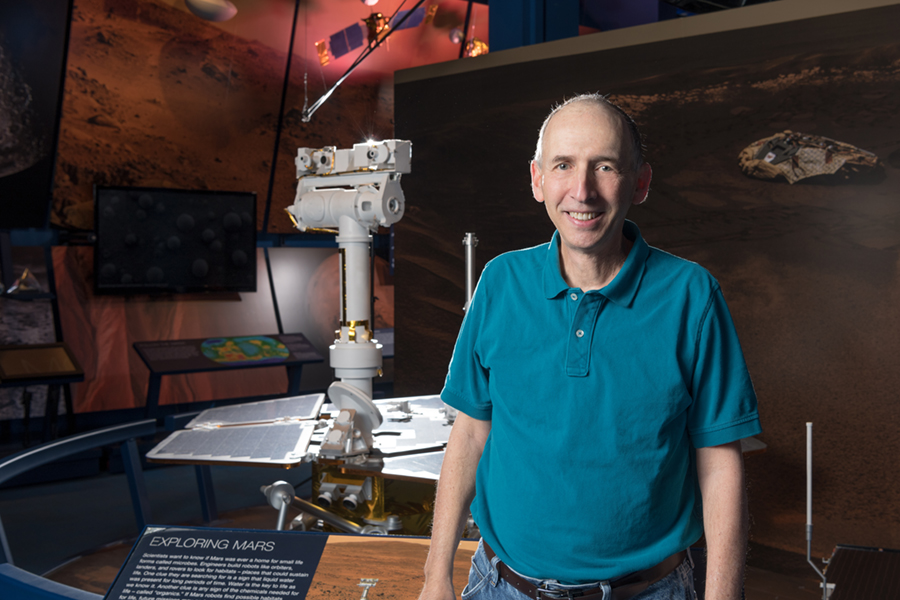Matt Golombek's Mission to Mars
The Rutgers alumnus, a planetary geologist at NASA’s Jet Propulsion Laboratory, oversees the smooth landings of spacecraft exploring Mars
Mars has a parking problem. Cliffs, craters, steep slopes, and large rocks clutter the landscape. But a spacecraft can’t settle just anyplace.
“You want it smooth, flat and boring,” says Matt Golombek, a planetary geologist at NASA’s Jet Propulsion Laboratory (JPL) in Pasadena, California.
Golombek, a 1976 Rutgers graduate, should know. Picking the parking space for the Mars probes—including the rovers Spirit, Opportunity, and Curiosity—is his specialty. Now, after 36 years with JPL, he’s leading the landing site team for NASA’s newest rover, launching in July 2020.

Matt Golombek in front of a model of a Mars Exploration Rover at NASA's Jet Propulsion Laboratory in Pasadena, Calif. (Photo: NASA/JPL-Caltech)
“I call myself the oldest Martian,” Golombek says.
During a landing, much can go wrong. Hit a big rock, and “the bottom of the spacecraft could break.” Arrive on a slope, and “it could tip over.” Rest on a “fluffy” surface, and “you’ll sink right into the dust and disappear.”
All were possibilities when Golombek’s latest assignment—NASA’s InSight, the $800 million lander—touched down last November on Elysium Planitia, a sandy plain just north of the Martian equator.
But the landing was flawless. Golombek was right again. “I’ve still got my job,” he jokes.
His team spent more than three years searching for the spot. Using high-resolution images taken by the Mars orbiters, they identified anything in the area the size of a meter (picture your coffee table). Then they went micro: “We measured the shadows of the rocks,” he says. “You don’t gamble. If you don’t land safely, you’re not going to get any science.”
Today, InSight sits on a bleak patch of butterscotch soil, identifying dust storms, meteor strikes and Marsquakes. Here, night temperatures regularly drop to 100 degrees below zero; the pink sky sustains an atmosphere one percent of Earth’s. All the way to the horizon, the topography appears cold and dreary.
“But dull is in the eye of the beholder,” Golombek says. “To geologists, there’s no place that’s dull.”
Growing up tens of millions of miles from Mars—in Hackensack, New Jersey—Golombek might not have made it even to Pasadena if not for a pivotal conversation with a Rutgers geology professor in 1974. “Toward the end of my sophomore year, I had to declare a major,” he says. “I walked into Geological Hall and told the secretary I was thinking about majoring in it.”
She immediately ushered him into the office of Ray Murray, the head of the department. “He kicked out a professor he was talking with,” recalls Golombek, “and spent 45 minutes talking to me about what classes I would take.”
Two years later, Golombek graduated with honors and highest distinction in geology. “That meeting probably mattered,” he understates.
Nearly 20 years later—around 1993, a decade after he joined JPL—the rover expeditions kickstarted, and a Mars renaissance began. Since then, Golombek has worked exclusively on Mars missions.
“This is right where the action is,” he says. “I’m incredibly fortunate to be in the middle of it.”
The new rover will look for signs of ancient life. (The likelihood of existing life, at least on the surface, is extremely remote.) Choosing the landing spot—Jezero Crater—took Golombek’s team about five years. For eons, the site has been dry and dead, but four billion years ago, when Mars was warmer and wetter, Jezero Crater contained a lake. Nobody is certain, but perhaps primitive microbes once flourished there.
“Life on Earth started pretty much as soon as liquid water was stable on the surface,” notes Golombek.
The rover will hunt for organic molecules sequestered in the rocks. Though not alive themselves, organics are “building blocks for life,” Golombek says. Samples, stored in pen-size tubes and stowed on the surface, will await pickup by a later mission; those caches will go back to Earth for analysis.
Finding extraterrestrials in our solar system—even fossilized alien bacteria—is one of astronomy’s holy grails. Whether extant or extinct, simple or smart, a second example will suggest to scientists that life is common throughout the galaxy.
“Here’s a planet right next door,” says Golombek, “where you can address one of the most compelling questions of science.” Fierce and forbidding, yet seductive as a siren song, Mars beckons. Golombek, among others, may soon decipher its lyrics.